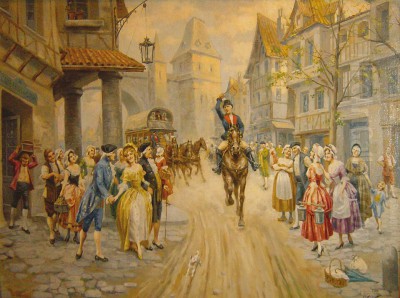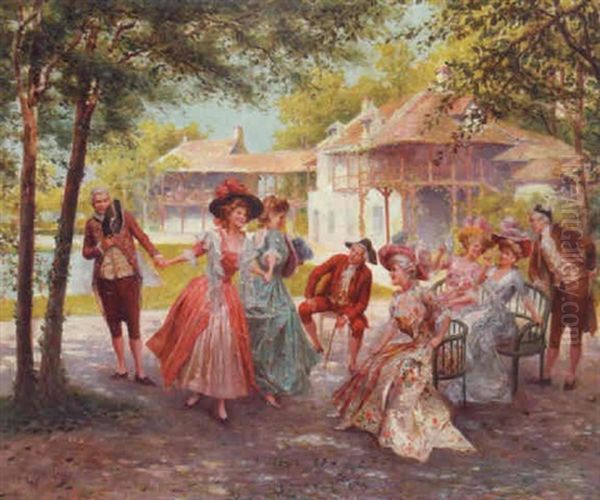
Mariano Alonso Pérez (1857-1930) was a distinguished Spanish painter whose artistic career flourished during the vibrant period of the late nineteenth and early twentieth centuries. Working primarily in oil paint, though also proficient in drawing, Alonso Pérez carved a niche for himself with his charming and elegant depictions of contemporary life and historical vignettes, often imbued with a sense of grace and luminosity that captivated audiences of his time. His work stands as a testament to the artistic currents flowing through Spain and France during the Belle Époque.
Early Life and Artistic Formation
Born in Zaragoza, Spain, in 1857, Mariano Alonso Pérez grew up in an environment that likely nurtured his artistic inclinations. Some sources suggest his father was also a painter, potentially providing early instruction and fostering a deep appreciation for the arts within the young Mariano. This familial connection to the art world may have played a significant role in shaping his future path and stylistic preferences.
While Zaragoza was his birthplace and formative environment, Alonso Pérez's life journey eventually led him to Barcelona, where he passed away in 1930. His trajectory reflects a pattern common among Spanish artists of the era, often moving between regional centers and the major artistic hubs of Madrid, Barcelona, or even Paris to further their careers and engage with broader artistic movements.
The Influence of Fortuny and French Currents
A defining characteristic of Mariano Alonso Pérez's art is its connection to the legacy of Mariano Fortuny y Marsal (1838-1874). Fortuny, a towering figure in 19th-century Spanish art, was renowned for his dazzling technique, brilliant use of light and color, and exquisitely detailed genre scenes, often historical or Orientalist in theme. Alonso Pérez clearly admired Fortuny's work, echoing his predecessor's penchant for intricate detail, vibrant palettes, and scenes brimming with life and anecdotal interest, often referred to as "tableautins" or small cabinet pictures.

Alonso Pérez adapted this influence to his own time, frequently depicting scenes inspired by late 19th-century Parisian life. He skillfully blended contemporary settings and activities with figures dressed in fashions reminiscent of earlier eras, particularly the 18th century, creating a slightly nostalgic, dreamlike quality. This playful ambiguity regarding time adds a unique layer to his genre paintings, suggesting a fascination with elegance across different periods.
Furthermore, Alonso Pérez's work reveals an awareness of French Impressionism and Post-Impressionism. The influence of artists like Pierre-Auguste Renoir can be discerned in his treatment of light and color, particularly in outdoor scenes or depictions of social gatherings. Like Renoir, Alonso Pérez often focused on the fleeting moments of leisure and the beauty of idealized figures, especially young women, capturing the joie de vivre associated with the Belle Époque. His backgrounds are often loosely painted or blurred, directing the viewer's focus squarely onto the expressive faces and gestures of his subjects.
Parisian Life and Salon Success
Paris, the undisputed capital of the art world in the late 19th century, exerted a strong pull on artists from across Europe, and Alonso Pérez was no exception. His work often reflects the themes and atmosphere of modern Parisian life – the bustling cafes, elegant soirées, and leisurely moments enjoyed by the bourgeoisie. He seemed particularly drawn to capturing the sophisticated charm and fashionable attire of the era.
His engagement with the Parisian art scene is evidenced by his participation in the prestigious Paris Salon. In 1901, he exhibited a work titled Bonne Farce (A Good Joke/Prank). The Salon catalogue for that year listed his address as 78 rue du Faubourg-Saint-Michel in the 10th arrondissement, providing a concrete link to his presence in the city. Exhibiting at the Salon was a significant achievement, offering artists exposure to critics, collectors, and fellow painters, and signaling a level of professional recognition. The title Bonne Farce suggests a lighthearted, narrative genre scene, typical of his oeuvre.
Notable Works and Themes
Throughout his career, Mariano Alonso Pérez created a diverse body of work. Several specific pieces offer insight into his style and thematic interests. An early work, Portrait charge de William Bouguereau (c. 1880), is a caricature portrait of the highly influential French academic painter William Adolphe Bouguereau. This piece, measuring 20.8 x 19.2 cm, demonstrates Alonso Pérez's skill in capturing a likeness while adding a touch of playful commentary, a common practice among artists in bohemian circles.

Spanish themes also feature in his work, as seen in Bailaorés (Flamenco Dancers). This painting (45 x 39.5 cm), signed in the lower right, tackles a subject deeply rooted in Spanish culture, often explored by artists seeking to capture the nation's unique identity and passion. It stands alongside works by other Spanish masters like Joaquín Sorolla or Ignacio Zuloaga who also depicted aspects of Spanish folklore and tradition.
Other documented works include El cartero (The Postman), a genre scene dating from the 19th century, and Una desgracia (A Misfortune), recorded in 1895. While El cartero likely portrays an everyday scene, Una desgracia hints at a more dramatic or sentimental narrative, showcasing a potential range beyond purely decorative subjects. These titles suggest an interest in storytelling and observing the nuances of human interaction.
A large oil painting, measuring 122 x 190 cm, is mentioned as being part of a series related to artists from Alicante and celebrating the artistic heritage of Zaragoza painters. Although details about this specific work are scarce in the provided context, its scale suggests it might have been a significant commission or exhibition piece, intended to make a substantial statement about regional artistic pride and lineage.
Versatility: Printmaking and Design
Mariano Alonso Pérez's artistic talents extended beyond the canvas. He engaged in printmaking, creating works such as Bal époque Louis XV (Ball in the Louis XV Era). This indicates his interest in historical settings, particularly the Rococo period associated with King Louis XV of France, known for its elegance, intimacy, and decorative flair. His exploration of printmaking allowed him to reach a wider audience and experiment with different visual effects inherent in graphic media.
Furthermore, Alonso Pérez demonstrated his versatility by venturing into decorative arts. He is known to have designed silk fabrics for Neyret Frères, a company likely involved in textile production. This collaboration highlights his ability to apply his aesthetic sensibilities to different mediums and underscores the interconnectedness of fine art and design during a period when movements like Art Nouveau were blurring these boundaries. Artists like Alphonse Mucha or members of the Vienna Secession similarly worked across various disciplines.
Artistic Style Revisited: Elegance and Idealization
Alonso Pérez's signature style remained relatively consistent, characterized by a focus on elegance, refinement, and idealized beauty. His figures, particularly women, are often depicted with delicate features, graceful postures, and fashionable attire. Whether set in contemporary Parisian salons or evoking 18th-century fêtes galantes, his paintings prioritize charm and visual pleasure.
His technique involved careful drawing and composition, combined with a painterly application of color that absorbed lessons from Impressionism without fully dissolving form. The frequent use of softer, less defined backgrounds serves to enhance the presence of the figures, making them the clear focal point. This approach aligns him with other successful Salon painters of the era, such as the Italian Giovanni Boldini or the French Paul César Helleu, who also specialized in portraits and scenes of sophisticated modern life. He navigated a path between the detailed finish of academic painters like Jean-Léon Gérôme or Bouguereau and the looser, light-filled canvases of the Impressionists.
Legacy and Recognition
Mariano Alonso Pérez achieved considerable success during his lifetime, exhibiting his work and finding patrons who appreciated his elegant style. Today, his paintings are held in various collections, including the Museo Goya - Colección Ibercaja - Museo Camón Aznar in his native Zaragoza. This museum's collection underscores his importance within the artistic heritage of the Aragon region. His works also appear in private collections and periodically surface on the art market, where they continue to be admired for their technical skill and nostalgic charm.
While perhaps not as widely known internationally as some of his Spanish contemporaries like Sorolla or Santiago Rusiñol, Alonso Pérez holds a secure place in Spanish art history as a skilled interpreter of the Belle Époque. He captured the spirit of his age – its fashions, its leisure activities, its aspirations towards elegance – with a distinctive blend of academic precision and modern sensibility, heavily influenced by the enduring legacy of Fortuny and the allure of Parisian art.
It is important to distinguish Mariano Alonso Pérez the painter from other individuals with similar names, such as Carlos Alonzo-Pérez (1882-1949), another Spanish artist active around the same time, or a professor Mariano Alonso Pérez noted in legal and educational fields. The painter's identity is firmly rooted in his artistic output from 1857 to 1930.
Conclusion: A Painter of Graceful Moments
Mariano Alonso Pérez y Villagrosa (using the more complete name often found in art historical records) remains a compelling figure in late 19th and early 20th-century Spanish art. His work offers a window onto a world of elegance, leisure, and refined beauty. Deeply influenced by the technical brilliance of Mariano Fortuny y Marsal and responsive to the atmospheric innovations of French Impressionism, particularly Renoir, he forged a personal style that resonated with the tastes of his time. From intimate genre scenes and historical evocations to portraits and decorative designs, Alonso Pérez consistently demonstrated a mastery of technique and a keen eye for capturing the graceful moments of life, leaving behind a legacy of charming and luminous paintings. His contribution enriches our understanding of the diverse artistic landscape of Spain during a period of significant cultural transformation.